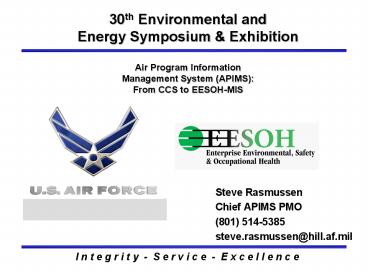Steve Rasmussen PowerPoint PPT Presentation
1 / 26
Title: Steve Rasmussen
1
30th Environmental and Energy Symposium
Exhibition Air Program Information Management
System (APIMS) From CCS to EESOH-MIS
- Steve Rasmussen
- Chief APIMS PMO
- (801) 514-5385
- steve.rasmussen_at_hill.af.mil
I n t e g r i t y - S e r v i c e - E x c e l
l e n c e
2
Air Quality Challenges
- Requirement Growth
- Emission Inventories
- Permits Permit Limits
- NSR/PSD Reviews
- Conformity
- Title V, NESHAP
- Material Phase Out
- Self Regulation
- Inspections
- Certifications
- Class II ODS Management
- Area Source Categories
- Urban Air Toxics
- 8 Hr Ozone PM 2.5 Stds
- More More Record keeping
- Declining Resources
- Manpower
- Turnover
- Funding Constraints
- A-76 Studies
3
Air Is The Greatest Risk
4
Visions for APIMS
- Air Force Vision for APIMS/CCS
- Create a World-Class Integrated Environmental,
Safety, - and Occupational Health System of Systems
- Develop federal, state, and local regulatory
reports - Identify health trends
- Provide environmental management tools
- Provide pollution prevention management tools
- Facilitate operational risk management
- Drastically reduces Costs by sharing information
- Reduce operational costs by making better
decisions
5
What is APIMS
- A primary component of Command Core System (CCS)
- An integrated relational database designed to
manage environmental, safety, and occupational
health datasets - APIMS is an air quality management tool that was
designed - to be flexible for use at any installation
- Track and prepare Air Emission Inventory
- Regulatory Compliance
- Permit, Title V, NESHAP
- Automated Logs
- Checklists
- Sharing the Data among Different Functional Areas
- More Efficient
- Reduces Cost
- One of the primary modules for EESOH-MIS
6
Major Benefits of APIMS
- Consistent Air Program Information Reducing
- AEI Reporting Cost
- Training and Certification Expenses
- Redundant Data Collection
- Administrative Burden
- Validated and Standardized Information to
support - P2 Opportunities
- Regulatory Opinions
- Congressional Data Calls
- Risk Analysis
7
The Process Is Key
8
Building Blocks Of Data
Annual Air Emission Inventory
Compliance
Air Management Tool Data Manipulation Custom
Reports
One Source of Data to Multiple Compliance Reports
9
APIMS Simplifying Data Collection
Single Point Data Collection and Management
10
The Future Is Now
As Is
To Be
Interim
Oracle 9i Unified DB
Oracle 8
Oracle 8
Oracle 8
Oracle 8
Oracle 8
Oracle 8 Site 2
Oracle 8 Site 1
CCS Site Server
Oracle Forms Server/ Oracle Web Cartridge
Web Server
LAN
Web Server
Middleware
PKI/VPN
Windows clients Oracle Net 8
GCSS
WAN
Independent Site Implementations
PKI/VPN
Independent Site Implementations
Independent Site Implementations
Browser Clients
Browser Clients
11
EESOH-MIS Overview
- Enterprise Environment, Safety, Occupational
Health Management Information System (EESOH-MIS) - Previously Automated Civil Engineering System
Environmental Module (ACES-EM) - Phased development/deployment of 18 environmental
applications - Intended to integrate with other ACES modules
- Operations
- Fire Department
- Housing Management
- Real Property
- Program Management
- Other modules
Part of the Air Force Modernization Program
12
EESOH-MIS Overview
- EESOH-MIS
- Focused on improving and standardizing business
practices - Integrated, multimedia system vs. multiple
stovepipe systems - Internal and external Air Force Interfaces
- EESOH-MIS will be a revolutionary, not
evolutionary change in the way the Air Force does
business - Is NOT an incremental adaptation and interfacing
of existing legacy systems - Strategic goals
- Integrated solution
- Adaptable
- Standardized
- Supports shared information
13
Integrating Functional Stovepipes
14
Integration What it Means
- Common data set
- Activities/Requirements/Functionality
- Identifies overlap eliminates redundancy
15
Finding the Common Ground
16
Defining the Common Data Set
- Material Product Data
- Metadata required for indexing, querying, and
calculations - Scanned MSDS Image
- Valued Added Data
Material Product Data
17
One View to a World of Information
Civil Engineering
Safety
Mission
Medical
Enterprise ESOH-MIS
Logistics
Environment
Shop Floor
18
Data Information Knowledge Power
ESOH-MS and EMS
ESOH-MIS
Knowledge Management
Mission Impact Assessment EMS Metric
Management Cross Facility Comparison Regulatory
Impact Assessment
Information Management
Pubic Image
Air Emission Inventory Rolling Emission Totals
NESHAP Compliance Conformity Analysis
Inspections and Oversight Process
Improvement Permit Compliance Reports Permit
Applications
Data Collection and Standards
Process/Aspect Definition Impact/Hazard
Definition Material Information Facility
Definition
Organization Definition Source Definition Regulato
ry Definition Compliance Definition
Permit Constraints Checklist Requirements Operatio
ns Logs Training Records
19
EESOH Installations Worldwide
Direct read from active EESOH systems to generate
Resource Capability Metrics
20
Knowledge Based Management
One Can Only Manage What One Can Measure
21
Supporting the Mission
RCM
ACESEMS Metrics
AFRIMSAF-EMISHMMSAPIMSCSI
Environmental
ESOH MIS DUSD (E) DUSD (OH) Metrics
ISO 14001 ESOH MS
ESOH MIS ESOH-MS Metrics
DOEHRS OH Metrics
CCS
Occupational Health
AFSAS SE Metrics
Aviation Ground Weapons
Safety
22
Spiral Development Phases
23
Why APIMS Now???
- APIMS is the Mature and Stable System, Today
- CCS EESOH-MIS interface
- BMMP, Activities Modeled from APIMS
- Centralize Air Quality Data
- Ensure Air Process Are Incorporated Into
- EESOH-MIS HazMat / HMMP
- Reduce Overhead by Managing Processes in HMMP
- Increased Knowledge Management
- APIMS Data Centrally Funded for Migration to
EESOH-MIS - An Investment in APIMS Is An
- Investment In EESOH-MIS
24
(No Transcript)
25
(No Transcript)
26
Questions?

